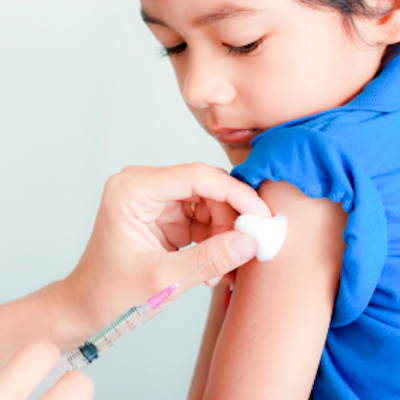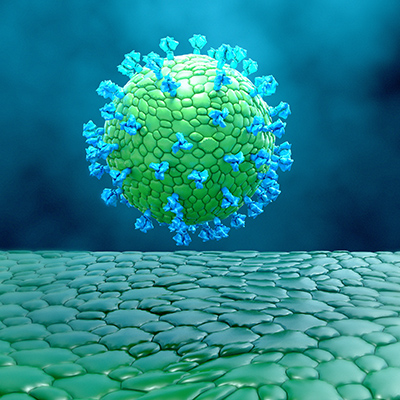November 16, 2020 -- Why do children seem to be more resistant to SARS-CoV-2 infection than adults? The answer may lie in the age-dependent presence of a key viral enzyme, transmembrane protease serine 2 (TMPRSS2), according to a new study published in the Journal of Clinical Investigation on November 12.
SARS-CoV-2 infection causes a range of clinical complications, ranging from carrying the virus asymptomatically to life-threatening multiorgan failure. The greatest morbidity and mortality from COVID-19, the disease caused by SARS-CoV-2, is seen in elderly populations, with the lowest rates in infants and young children. In fact, up to 90% of children infected with SARS-CoV-2 exhibit no or mild symptoms.
Previous research has shown that SARS-CoV-2 gains cellular entry by binding to the human receptor angiotensin-converting enzyme 2 (ACE2) and fusing with the cell membrane after the spike glycoprotein undergoes protease-mediated cleavage, facilitated by TMPRSS2. While ACE2 expression is generally low and restricted to epithelial cells, TMPRSS2 expression is broad and high in ciliated and alveolar type 1 (AT1) cells.
Differential expression of viral attachment and viral entry factors across lung development may provide an explanation for the variability in COVID-19 infection presentation, according to researchers at Vanderbilt University Medical Center (VUMC). Specifically, the authors of the current study wondered if TMPRSS2 had something to do with the greater severity of COVID-19 symptoms observed in older people compared to children.
"Our study provides a biologic rationale for why particularly infants and very young children seem to be less likely to either get infected or to have severe disease symptoms," said lead author Dr. Jennifer Sucre, assistant professor of pediatrics (neonatology) at VUMC, in a statement.
The researchers analyzed a single-cell RNA sequencing (scRNAseq) dataset profiling the epithelial and stromal cells in developing mouse lung at five timepoints, ranging from embryonic day 18 (E18) to postnatal day 64. In total, they interrogated expression profiles of genes linked to SARS-CoV-2 infectivity by analyzing a total of 67,629 cells across the five timepoints. They found that TMPRSS2 expression in ciliated cells was significantly higher at postnatal day 64 compared to all earlier developmental timepoints.
This analysis was followed by performing RNA-in situ hybridization (ISH) with automated quantification on time points corresponding to the scRNAseq data. TMPRSS2 expression was colocalized with four types of epithelial cells: Scgbla1 (representative of secretory cells), Foxj1 (representative of ciliated cells), Sftpc (representative of AT2 cells), and Hopx (representative of AT1 cells) in mouse lung samples from E18 up to 2-year-old mice.
The results revealed that TMPRSS2 protein expression was colocalized in ciliated cells expressing Foxj1 and AT1 cells expressing Hopx.
"What we found is that expression of (TMPRSS2) goes up significantly with aging, and we see that at the level of the gene and at the level of the protein," Sucre said. "We see a lot more TMPRSS2 in older individuals, in both humans and mice."
To determine if TMPRSS2 expression increases with aging in humans, the team examined TMPRSS2 expression by RNA-ISH with automated quantification and by immunofluorescence using a monoclonal antibody to TMPRSS2 in lung tissue from samples across the human lifespan. Infants (individuals up to 2 years of age) expressed TMPRSS2 at very low levels, while children (ages 3-17) exhibited similarly low levels of TMPRSS2 in secretory and alveolar epithelial cells with a significant increase in FOXJ1+ ciliated cells.
Adults had higher TMPRSS2 expression in secretory, ciliated, and AT1 cells relative to both pediatric groups with very little TMPRSS2 expression in AT2 cells. Alternatively, human lung tissue demonstrated low levels of ACE2 expression in infants, children, and adult samples.
The rising expression of TMPRSS2 with age in both conducting airways and alveolar epithelium of the lungs may explain the increased susceptibility to symptomatic infection and severe acute respiratory distress syndrome associated with SARS-CoV-2 infection observed in adults relative to children, according to the authors.
They proposed that the very low levels of TMPRSS2 expression in human infants, and nearly absent levels of expression of TMPRSS2 in prenatal mice, provide a mechanism by which young individuals may be relatively more protected against severe forms of COVID-19.
"We do think TMPRSS2 could be an attractive target both in treatment and potentially as a prophylaxis for (preventing infection in) people at high risk of COVID exposure," Sucre explained.
Do you have a unique perspective on your research related to infectious disease research? Contact the editor today to learn more.
Copyright © 2020 scienceboard.net










